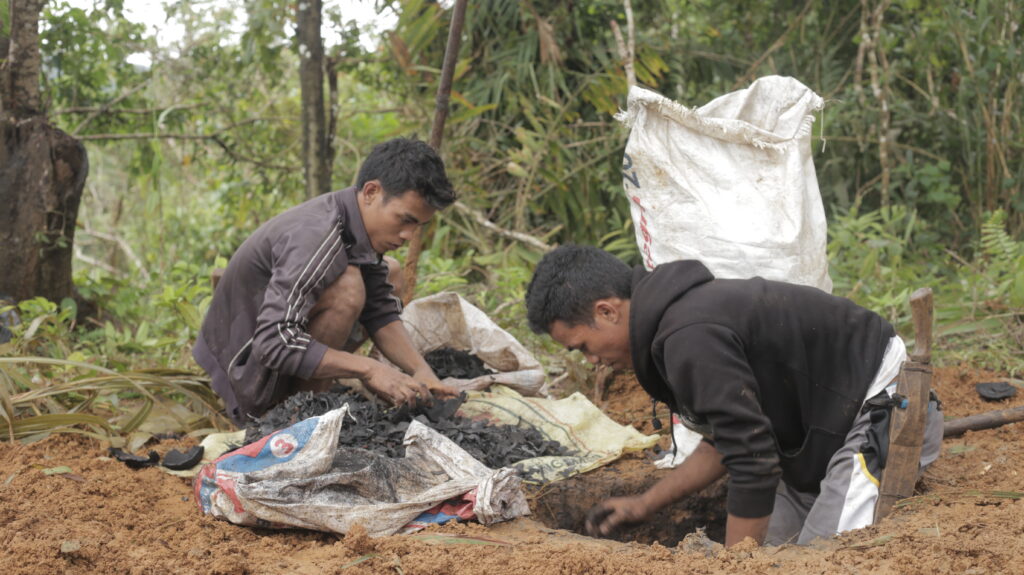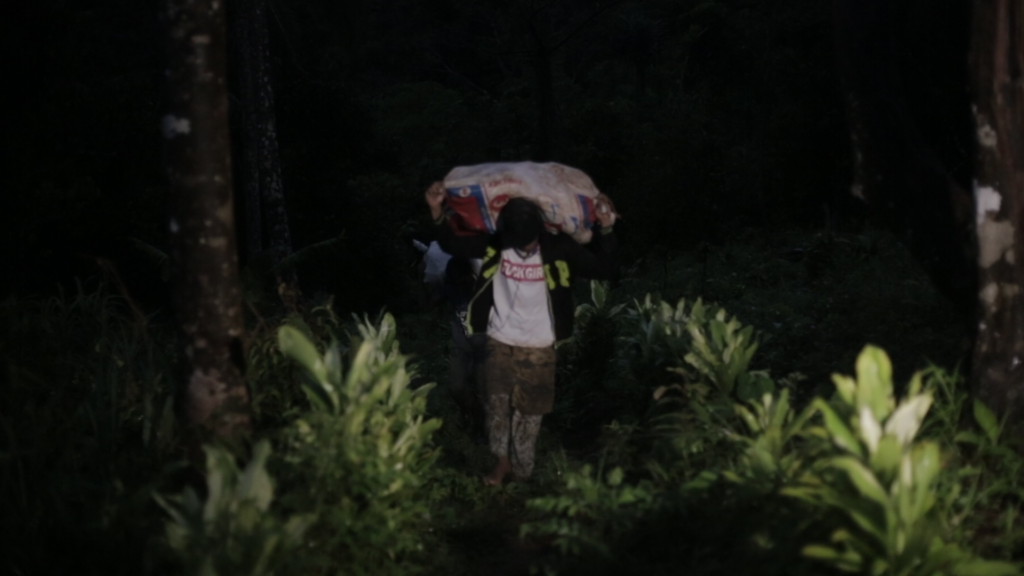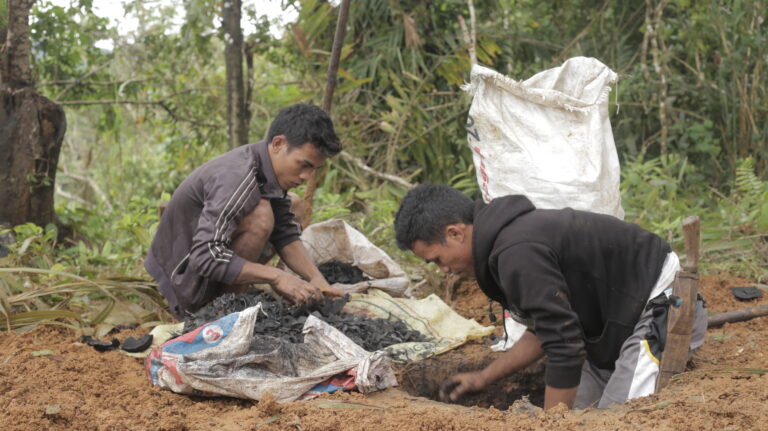“ULING” (Filipino term for charcoal) – Unequal . LIving . No . Guarantee
An all-night standing beside a pit-producing clouds of smoke that penetrates through nostrils deep down the chest and lungs was a serious feeling of laceration that I must admit not everyone endures.

The Albano brothers could not blur a detail of how a life of a charcoal maker goes. From how they go through sleepless nights, survive from the suffocating fire to the inexhaustible limbs and thighs to carry heavy charcoals down the slippery mountains.
It was always a long night for these charcoal makers and it begins when the fire starts to ignite.
Sleepless nights for a cup of rice

An energy of a normal person lasted until 6’oclock or when they completed 8 to 9 hours of duty. On daily basis traffic congestions happened when these workers rush to go home or chill on convenient stops. In other words, everyone rushes to relax.
But how are we going to exempt some people who also rush to labour for the rest of the night? Mark John, 24 and his younger brother Ansel, 21 look like having the same steady strength to face another task. From their day job as a farmer and a construction worker, these brothers trekked some three kilometres mountain site to collect sacks of coconut shells and make it another source of income.
Due to the unceasingly wide-spread of the Covid-19 pandemic, job opportunities and even available jobs were apparently becoming limited. Below minimum income workers especially in the rural areas could not pretend to have the same decent life they enjoyed before.
Mark John and Ansel realised that their knowledge on charcoal making way back childhood could bring a little hope for their families.
Charcoal Industry in the Philippines
Due to being cost-effective, the country still highly patronizes the charcoal market. The recent data of the Department of Energy (DoE) shows that there are 33.12 million metric tons (MT) of coal that was used in 2019. The country imported the 26.98 million MT while 5.03 million MT was made locally.

It was in 2017 when the Philippines produced almost 240 thousand cubic meters. However, there was a clear downward in volume production in the last ten years. In the 2008 the total volume of charcoal made locally was amounted to 610 thousand cubic meters.
Some of the industries listed to be the biggest supporters of coal in 2015 were cement, alcohol, sinter, rubber boots and paper, also industries that are belonging to chemical manufacturing, fertilizer production and smelting process.
Coconut shell
It bothers a lot knowing that these two make charcoal to escape the point of starving. Thus, we could not help but ask their awareness on the regulations of the Environmental agency which covers the allowable materials that could only be utilized to pursue this doing.

The eldest had a chance of showing us up-closely the sacks of coconut shells from the two farms. Mark John was just 14 when his father taught him how to make charcoal out of coconut shells. As a child from a farmer’s home, he had clutched some basic about charcoal making. It was their father who practiced charcoal making out of the forest waste right after he worked on his farm.
A sack of coconut shell charcoal recently cost Php. 450.00 around ($9.00). It is much expensive than with other charcoal that only ranges to Php. 150.00 – Php. 300.00 per sack.
Aside from coconut shell, some agricultural waste which can be considered as sustainable options has been permitted in charcoal making under the country’s existing law. This includes palay husks, coconut coir, hay and cogon, sawdust, sugarcane stalks and weeds, corncobs, leaves and even grass can be turned to charcoal bricks.
At 7, the Abano brothers dig a pit perhaps 4-feet deep fitted for the two sacks of coconut shells. After an hour, Mark John ignited two shells and place it at the very bottom of the pit. The smoke started to scatter. We did not know where to go to avoid that heavily suffocating smoke. But these brothers did not stop placing each coconut shell on the pit until they filled it entirely.
Four straight hours inhaling a smoke seems impossible, yet each night, they manage to breathe this whole stuff.
Health hazards
Mark John and Ansel works without preservations. Because they were both young, it takes sometimes before they could feel the pain of a 24-hour labour. But what actually the most possible problem to occur in the long run could be the result of their too much smoke exposure.
This traditional charcoal industry emits harmful gases containing carbon monoxide and methane which can cause some fatal health conditions such as asthma, heart and lung ailment, neurological problem and the worst is cancer.
Mark John is basically aware of lung illnesses. He also worries for himself and for his brother yet it could not withdraw them from charcoal making without an assurance of having a replacement job.
“Delikado po sa kalusugan, magkaroon ng TB, ah dala nalang po namin iyong aming pag-iingat para rin po sa ikabubuhay ng aming pamilya.”
[“This job could be dangerous as we could have tuberculosis, but we are just doing it safely for the sake of our family.”]
Environmental Hazards
Deforestation or the clearance of woodland in the tropical countries like the Philippines had been massively and rampant few years back. This illegal act has been an open secret yet its environmental impact and devastation could hardly be kept secret.
The Center for International Forest Research reported this year that the contribution of charcoal production in the year 2009 to deforestation in the Tropical countries was estimated at less that 7 percent.
On the same year, the said research group conveyed that there is approximately 71.2 million tons carbon dioxide and 1.3 million tons methane was emitted in the tropical ecosystem.
In mid of this forerunning environmental issues, the World Wildlife Fund (WWF org.), an environmental organization for the wildlife conservation and endangered species discovered the utilisation of “Green Charcoal” also known as “Biochar.” The organisation suggested that this source of energy has a minimal environmental impact as it was made through a clean processed out of biomass or the spare in the harvest of staple crop in the provinces and sugar cane.
May the Hard work pays-off
They yielded a sack and half of coconut shell charcoal the following day. The brothers were having an equal portion of the money since they started to make charcoal.
The good weather was not yet in the mood to show-off when they decided to go down the mountain to meet their buyers.
Although, it is quite unreasonable to wallow oneself in the risk that can actually be ran-off. The Abano brothers, similar with other charcoal makers have chosen to stay because they have reasons that weighs greater than their own’s sake.
